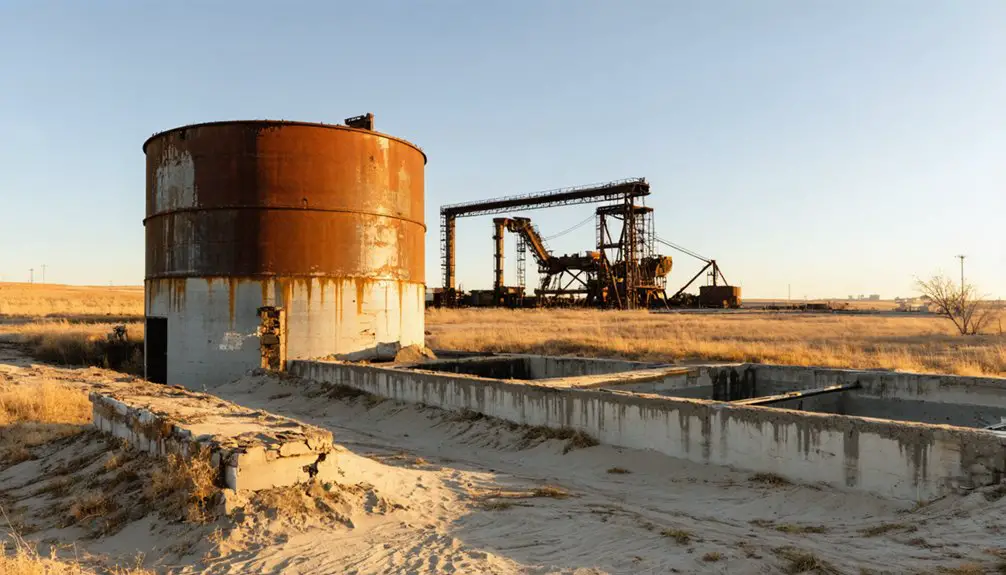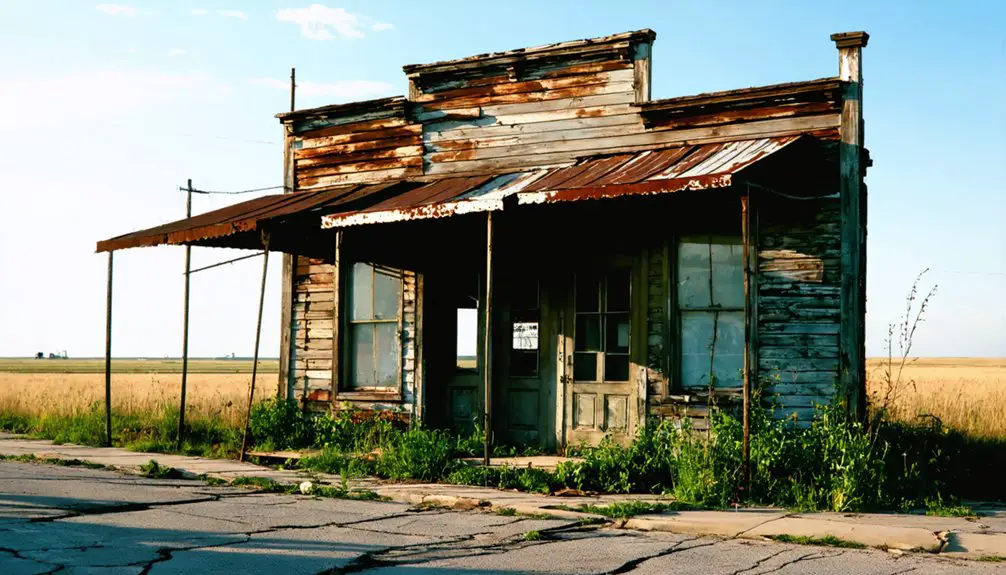You’ll find the ghost town of Antioch, Nebraska along Highway 2, where crumbling ruins tell the story of a remarkable World War I potash boom. When German potash imports stopped in 1916, this tiny settlement of 175 people exploded into an industrial powerhouse of 2,000 residents, with five major reduction plants processing alkaline lake brine. By 1921, cheaper European imports returned, and Antioch’s population plunged to fewer than 25. The ruins stand as silent witnesses to this fascinating chapter of American ingenuity.
Key Takeaways
- Antioch transformed from a booming potash production town of 2,000 residents during World War I to a ghost town by 1921.
- The town’s rapid decline occurred when cheaper European potash imports resumed after WWI, forcing all local plants to close.
- Historical ruins of five major potash reduction plants remain visible along Nebraska Highway 2, about two miles from Ellsworth.
- During its peak, Antioch was Nebraska’s potash capital, processing brine from alkaline lakes to produce fertilizer materials.
- Today, fewer than 25 residents remain in Antioch, with only crumbling industrial remnants marking its once-prosperous past.
The Rise of Nebraska’s Potash Capital
When World War I cut off America’s access to German potash supplies, a groundbreaking extraction method developed by University of Nebraska chemistry graduates in 1916 transformed Antioch into the state’s potash capital.
This potash innovation allowed the U.S. to achieve economic independence from European imports during wartime by utilizing brine from the region’s abundant alkaline lakes.
Innovation born of necessity: American scientists transformed alkaline lakes into a vital wartime resource, freeing the nation from European potash dependence.
Like the ancient city of Antioch in Syria, which grew from 25,000 to over 500,000 residents, this Nebraska town experienced dramatic population growth.
You’ll find that Antioch quickly evolved from a small village into a thriving industrial hub, with five major factories established near railroad lines by 1918.
The American, Nebraska, Alliance, National, and Western potash plants drove unprecedented growth, attracting thousands of workers to the area.
The town’s population exploded to between 2,000 and 5,000 residents as the critical mineral production supported both agricultural needs and the broader war effort.
The prosperity was short-lived as foreign competition from cheaper French and German potash led to the industry’s collapse by 1921.
World War I’s Impact on Local Industry
The outbreak of World War I transformed Antioch into a bustling industrial powerhouse as the U.S. sought domestic alternatives to German potash.
You’d have witnessed massive industrial growth as five major reduction plants sprang up, including American, Nebraska, Alliance, National, and Western facilities.
The war economy drove rapid technological innovation in potash extraction. Before WWI, potash sold at stable $8-10 prices per ton until dramatic wartime increases.
You would’ve seen an intricate system of pumps moving brine from alkaline lakes to reduction plants near railroad lines.
While the potash technology promised great returns, you’d have also noticed the dangers – fires and explosions frequently disrupted operations, causing extensive damage to facilities.
The industry’s intense wartime expansion brought both opportunity and risk to Antioch, swelling its population to 2,000 as workers and entrepreneurs rushed to capitalize on soaring potash prices.
Life During the Potash Boom Years
During Antioch’s meteoric rise as a potash powerhouse, you’d have witnessed an astounding transformation as the town’s population exploded from 175 to nearly 2,000 residents within just three years.
You’d find workers earning impressive wages of $8 per day in the bustling potash production facilities, where innovative extraction methods turned alkaline lake brine into valuable industrial products.
Life in town hummed with modern conveniences – electricity from the Nebraska Potash Company lit your home, while new telephone lines kept you connected to neighboring communities.
You could catch the bus to Alliance for supplies, and the constant activity of the processing plants, running day and night, signaled prosperity.
Despite occasional challenges like plant fires, the rapid industrial growth created a vibrant community where steady employment and technological progress defined daily life.
The boom was driven by World War I cutting off America’s access to European potash sources, forcing domestic production to meet agricultural demands.
From Bustling Town to Abandoned Settlement
As you explore Antioch’s dramatic transformation, you’ll find a town that swelled from a small frontier village to a bustling industrial center of 2,000-5,000 residents during the World War I potash boom.
When cheaper European potash imports resumed after the war in 1918, Antioch’s economy crumbled, leading to the swift closure of all potash plants by 1921.
Much like the decline of Antioch in the Middle Ages due to warfare and natural disasters, the town’s population plummeted to fewer than 25 people within a few years as workers and their families abandoned their homes in search of new opportunities.
Today, visitors driving along Highway 2 can explore the haunting ruins of this once-prosperous town.
Population Rise and Fall
Prior to 1916, Antioch existed as a modest village of fewer than 100 residents, featuring just one school, a church, and a store in Nebraska’s sparsely populated Sandhills region.
When potash was discovered that year, you’d have witnessed an unprecedented population surge as workers flooded the area. By 1918, Antioch’s population demographics had exploded to over 5,000 people, transforming the quiet village into Nebraska’s bustling potash capital.
The rapid growth brought significant community challenges, from housing shortages to sanitation issues. The town’s success relied on its five potash plants that operated during this period.
However, this prosperity wouldn’t last. After World War I ended, cheaper European potash imports forced local factories to close. By 1921, Antioch’s population had plummeted dramatically.
Today, fewer than 25 people remain in what’s now considered a ghost town.
Economic Boom to Bust
When World War I disrupted European potash supplies in 1916, Antioch transformed into Nebraska’s leading potash production center.
You’d have witnessed the town’s remarkable economic resilience as it expanded from a tiny village to a bustling community of 2,000 residents. Five active plants processed brine from local lakes, creating essential materials for fertilizers and manufacturing.
Today, visitors can see the crumbling potash ruins that stand as silent sentinels of this industrial era. At its peak in 1917, the town reached over 5,000 residents as the potash industry boomed.
But Antioch’s prosperity proved short-lived. When the war ended in 1918, cheaper French and German potash flooded back into the market.
These dramatic market fluctuations devastated the local industry – by 1921, the last plant had shut down. Workers and their families departed as quickly as they’d arrived, leaving behind abandoned factories and silent rail lines.
The town’s rapid decline serves as a stark reminder of how quickly fortunes can change in single-industry communities.
Exploring the Historic Potash Ruins Today

The crumbling stone and concrete remnants of Antioch’s once-bustling potash industry stand as silent sentinels along Nebraska Highway 2 in rural Sheridan County.
You’ll find these historic ruins about two miles from Ellsworth, where reduction plants and pumping stations showcase nearly a century of industrial heritage.
While there’s no visitor center, historical markers guide you through the site’s significance during WWI-era potash production.
Though lacking modern amenities, interpretive signs reveal the stories of Nebraska’s potash pioneers during the Great War.
- Wind-worn concrete foundations stretch across the landscape
- Weathered stone walls rise from prairie grass
- Rustic pump house structures dot the alkaline lake area
- Historic markers detail the chemical innovations of local graduates
- Railroad-side reduction plant remains hint at bustling wartime activity
These ruins offer you an unfiltered window into Nebraska’s industrial past, perfect for self-guided exploration and photography.
Preserving a Unique Chapter of American Industry
Recognizing Antioch’s essential role in America’s wartime industrial effort, preservationists have worked diligently to maintain the physical remnants and historical legacy of Nebraska’s potash boom.
Today, you’ll find historical markers dotting the landscape where this important industry once thrived, telling the story of how local chemists developed innovative methods to extract potash from the region’s alkaline lakes.
The ruins of reduction plants and pumping stations stand as silent witnesses to Antioch’s industrial heritage, drawing history enthusiasts and researchers alike.
While the town itself has faded into ghost town status, state and local initiatives guarantee that you won’t forget its significance.
These potash preservation efforts remind you of a unique moment when Nebraska’s Sand Hills helped America overcome its wartime fertilizer shortage, fundamentally changing the nation’s agricultural capabilities.
Frequently Asked Questions
Are There Any Dangerous Areas Visitors Should Avoid When Exploring Antioch?
You’ll need to avoid abandoned structures, unstable building ruins, and alkaline lake shores. Take safety precautions near old mining sites, which may have hidden holes and hazardous chemical residues.
What Wildlife Can Typically Be Found Around the Abandoned Town Today?
Among 25+ local species, you’ll spot white-tailed deer, coyotes, and prairie dogs roaming freely. Watch for red-tailed hawks soaring overhead, while bats and swallows claim abandoned structures at dusk.
Is Special Permission Required to Visit and Photograph the Ruins?
You’ll want to check local authorities for specific photography guidelines, though no formal permits are typically required. Follow basic visitor etiquette by respecting private property and not disturbing historical structures.
Does Anyone Maintain Genealogical Records of Former Antioch Residents?
You’ll find former residents’ genealogical research maintained through Sheridan County Historical Society, local archives, and cemetery records. Check FamilySearch.org and NebraskaGravestones.org for detailed family histories and documentation.
What Artifacts From Antioch’s Heyday Have Been Preserved in Museums?
You’ll find mining equipment, factory remnants, and potash samples on display in regional museums, particularly at Sheridan County Historical Society, highlighting the historical significance of early 20th-century potash production.
References
- https://www.onlyinyourstate.com/state-pride/nebraska/fascinating-highway-ruins-ne
- https://en.wikipedia.org/wiki/Antioch
- https://history.nebraska.gov/marker-monday-antioch-potash-boom-town/
- https://visitnebraska.com/trip-idea/explore-7-authentic-ghost-towns-nebraska
- https://odysseythroughnebraska.com/potash-plant-antioch-nebraska/
- https://kids.kiddle.co/Antioch
- https://www.visitsheridancounty.com/photojourney/antioch-potash-plant-ruins/
- https://www.youtube.com/watch?v=FkVqVu-Njk4
- https://history.nebraska.gov/wp-content/uploads/2017/12/doc_publications_NH1987Potash.pdf
- https://www.visitsheridancounty.com/wp-content/uploads/2021/02/POTASH.pdf



